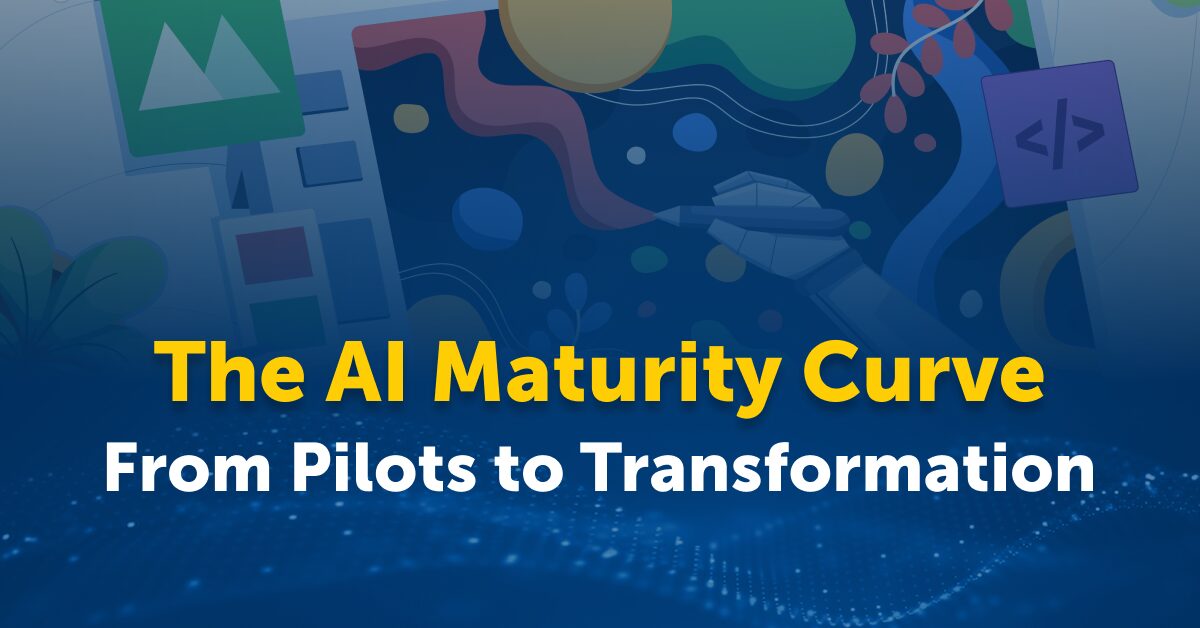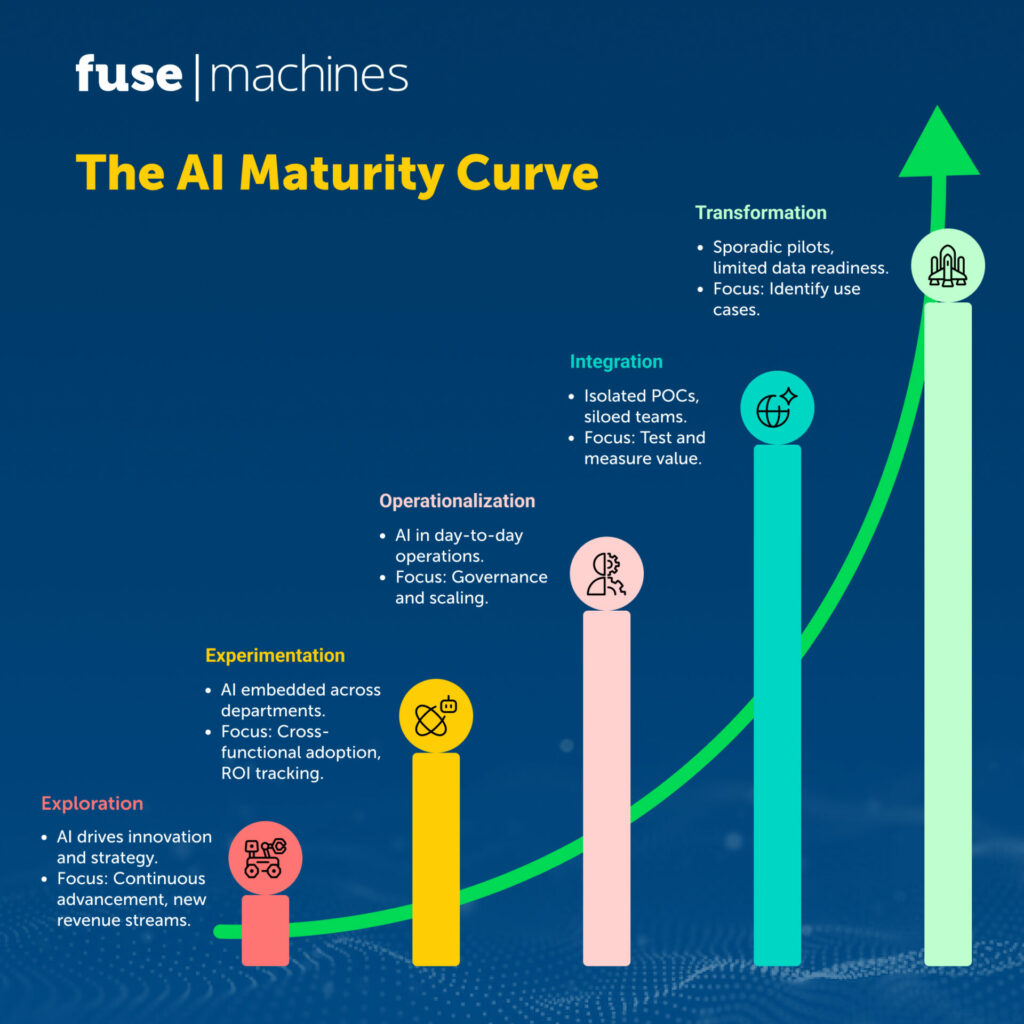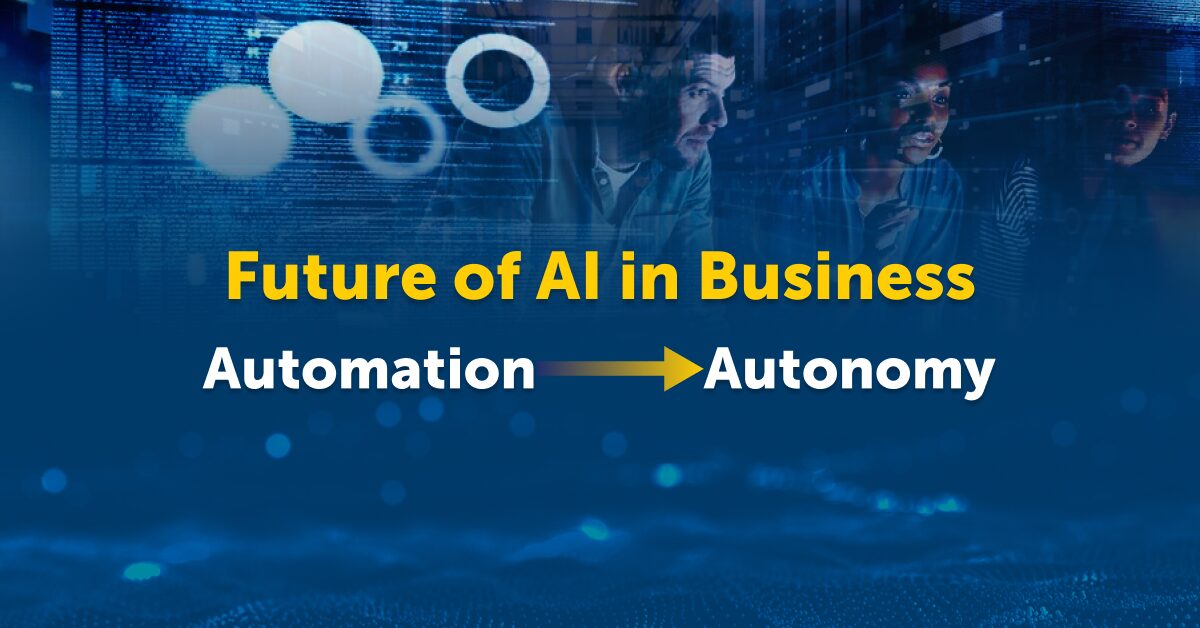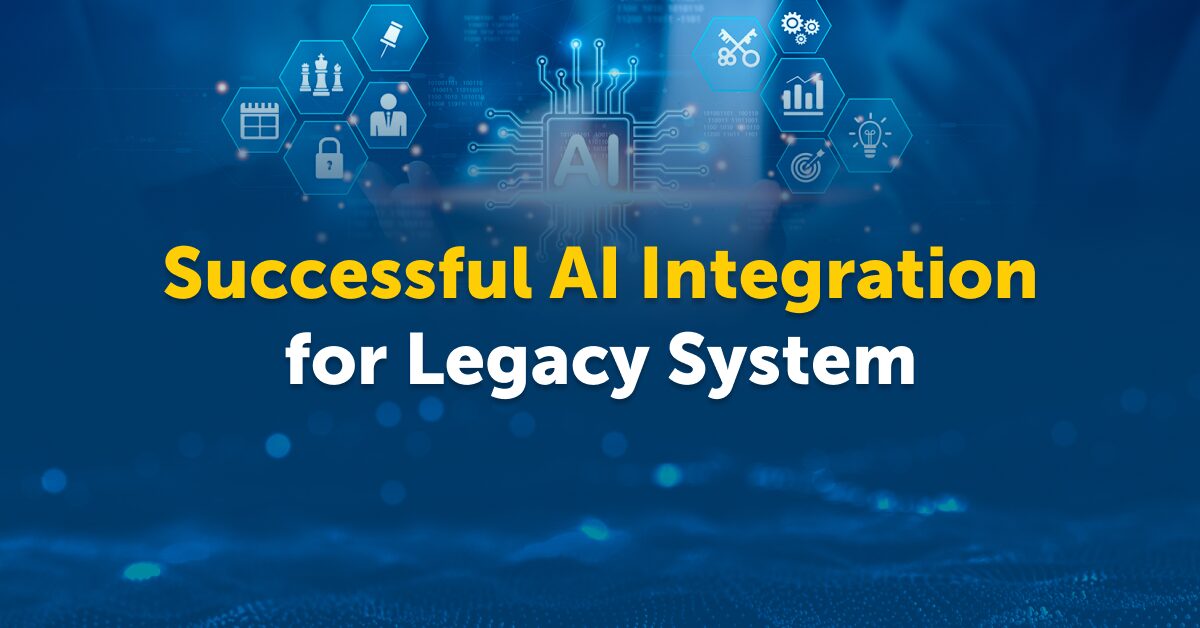The AI Maturity Curve: Where Your Business Stands and How to Advance

AI is now part of everyday business discussions, but success rates remain low. Many companies have launched pilots, yet only a few have managed to scale those efforts into lasting impact.
The difference comes down to maturity. The AI maturity curve is a way to understand how prepared an organization is to move from early trials to enterprise-wide adoption. It highlights the role of data, leadership, governance, and culture in shaping progress.
For executives, knowing where the business stands on this curve is critical. It helps avoid wasted investment, focus resources on the right priorities, and build a clear path toward sustainable growth with AI.

Want guidance from an AI expert on how to implement AI in your business? Contact Fusemachines today!
Understanding the AI Maturity Curve
The AI maturity curve is best understood as a progression of capabilities that builds over time. Each stage represents not only a level of technical sophistication but also an organizational mindset. Businesses that advance effectively balance three pillars: technology, people, and governance.
Unlike a one-time digital transformation project, AI maturity is dynamic and iterative. Companies may advance, plateau, or even regress depending on leadership decisions, regulatory changes, or market shifts. Viewing AI as a maturity journey allows leaders to:
- Benchmark their current state: Are they still testing pilots, or have they operationalized AI at scale?
- Prioritize investments wisely: Should resources go into infrastructure, workforce training, or scaling successful pilots?
- Identify organizational gaps: Are governance and risk frameworks keeping pace with technical deployments?
- Plan for long-term competitiveness: Maturity is not about adopting the latest tools, but about embedding AI into the operating model.
It is also important to note that maturity does not look identical across industries. For example, a financial services firm may achieve integration through risk modeling and fraud detection, while a retailer may get there through dynamic pricing and customer personalization. What unites them is the ability to move from tactical experimentation to enterprise-wide transformation that shapes strategy itself.
The curve can be visualized as five progressive stages: Exploration, Experimentation, Operationalization, Integration, and Transformation. Each stage introduces higher stakes, stronger value, and greater responsibility. Advancing is not automatic, and leaders must carefully manage both the pace and the direction of their journey.

Stage 1: Exploration
This is where most organizations begin their AI journey. Curiosity is high, and leaders are eager to understand what AI can do for the business.
Characteristics of Exploration:
- Sporadic pilots and isolated discussions about AI opportunities.
- Limited or poor-quality data.
- Lack of clear strategy or alignment with business goals.
Common Pitfalls:
- Pursuing AI because it is trendy rather than because it solves a real business problem.
- Investing in technology without preparing the data infrastructure to support it.
What Businesses Should Do:
- Conduct an AI readiness assessment to evaluate data availability, infrastructure, and organizational appetite for change.
- Identify high-impact use cases that align with strategic goals rather than novelty experiments.
- Begin building a governance framework early to set guardrails for responsible AI use.
Stage 2: Experimentation
Once organizations identify potential opportunities, they typically move into experimentation. This involves proof-of-concepts (POCs) and pilots led by individual departments.
Characteristics of Experimentation:
- Isolated pilots driven by motivated teams.
- Early efforts to test algorithms and measure outcomes.
- Limited executive oversight or enterprise-wide involvement.
Common Pitfalls:
- Projects remain siloed and fail to scale beyond the department where they were initiated.
- Lack of clarity on ROI, which makes it difficult to secure further investment.
What Businesses Should Do:
- Establish cross-functional collaboration to ensure AI pilots are not isolated experiments.
- Define clear KPIs for each project to measure success in terms of efficiency, revenue impact, or customer experience.
- Create a feedback loop to capture lessons from pilots and inform future projects.
Stage 3: Operationalization
At this stage, organizations begin embedding AI into day-to-day processes. It is a significant milestone because it moves AI from experiments to actual operations.
Characteristics of Operationalization:
- AI supports ongoing business functions such as forecasting, customer service, or supply chain planning.
- More reliable data pipelines are created to feed AI models.
- Governance begins to take shape, but gaps remain.
Challenges in this Stage:
- Technical debt emerges when pilots are scaled without sufficient planning.
- Workforce resistance grows as employees fear automation will replace their roles.
- Governance, ethics, and compliance frameworks are often underdeveloped.
Best Practices to Advance:
- Invest in change management programs to educate employees on AI’s role as an enabler, not a replacement.
- Build robust data governance systems to ensure quality, compliance, and security.
- Introduce training programs to upskill teams so they can effectively work alongside AI tools.
Stage 4: Integration
In this stage, AI becomes embedded across multiple business units. The organization is no longer experimenting with AI but systematically using it as part of core functions.
Characteristics of Integration:
- AI is applied across departments such as finance, HR, operations, and marketing.
- AI councils or leadership committees oversee implementation and governance.
- The business begins measuring ROI consistently across initiatives.
Challenges to Overcome:
- Scaling sustainably while avoiding overextension.
- Managing regulatory compliance across different markets.
- Balancing innovation with accountability.
What Executives Should Focus On:
- Align AI initiatives closely with corporate strategy to ensure every project drives measurable value.
- Appoint or empower leadership roles such as a Chief AI Officer (CAIO) or establish cross-functional AI councils.
- Create enterprise-wide ROI tracking mechanisms that measure outcomes consistently across projects.

Learn how to translate the AI maturity curve into action with our AI Readiness Framework
Stage 5: Transformation
This is the peak of the maturity curve. AI is no longer a tool but a central driver of competitive advantage, innovation, and strategy.
Characteristics of Transformation:
- AI shapes business models and drives entirely new revenue streams.
- Predictive and proactive AI systems support decision-making at every level.
- The organization partners with external ecosystems such as startups, academia, and technology providers to stay ahead.
Executive Priorities in Transformation:
- Constantly innovate by exploring new applications of AI beyond current markets and products.
- Maintain strong governance and compliance frameworks as regulatory scrutiny increases.
- Build an AI-driven culture where every employee understands how to use AI responsibly and effectively.
How to Assess Your AI Maturity Level
Before committing to the next stage of AI adoption, executives must gain a clear understanding of their organization’s current maturity. Many leaders overestimate their readiness, leading to failed initiatives, wasted budgets, and resistance from employees. A structured self-assessment allows decision makers to pinpoint strengths, uncover gaps, and prioritize the right investments.
Four Core Dimensions of AI Maturity Assessment
- Data Readiness
- Assess whether your data is accurate, reliable, and accessible across the organization.
- Look at whether you have broken down data silos or if key datasets remain locked in individual departments.
- Evaluate the extent of your data governance practices including security, privacy, and compliance with regulations such as GDPR or HIPAA.
- Executive question to ask: Can my organization generate insights from data within days, or are we still waiting weeks for basic reports?
- Assess whether your data is accurate, reliable, and accessible across the organization.
- Governance and Risk Management
- Review whether there are formal policies governing ethical AI use, bias mitigation, and accountability.
- Consider whether you have a centralized AI oversight body such as an AI council or steering committee.
- Identify how your organization approaches regulatory uncertainty. Are you actively monitoring upcoming laws and preparing compliance frameworks, or waiting until rules are enforced?
- Executive question to ask: If an AI system produced an error that harmed a customer, do we know who is accountable and how to respond?
- Review whether there are formal policies governing ethical AI use, bias mitigation, and accountability.
- Workforce Skills and Culture
- Gauge whether employees have baseline AI literacy and understand how AI tools impact their workflows.
- Assess reskilling initiatives. Are teams being trained to use AI systems, or is AI adoption limited to a small group of specialists?
- Evaluate cultural readiness: Do employees see AI as a partner in their work, or do they view it as a threat?
- Executive question to ask: Are my managers equipped to lead hybrid human-AI teams, or are we expecting employees to figure it out themselves?
- Gauge whether employees have baseline AI literacy and understand how AI tools impact their workflows.
- Integration Across the Business
- Examine how broadly AI is applied. Is it limited to isolated pilots in marketing or customer service, or is it woven into finance, operations, HR, and product development?
- Look at whether AI systems are connected to core processes like supply chain, compliance, or risk management.
- Evaluate whether AI investments are aligned with strategic objectives or remain side projects without clear sponsorship.
- Executive question to ask: If AI initiatives stopped tomorrow, would the business still run the same way, or would we lose a core advantage?
- Examine how broadly AI is applied. Is it limited to isolated pilots in marketing or customer service, or is it woven into finance, operations, HR, and product development?

Learn how to translate the AI maturity curve into action with our AI Readiness Framework
The Importance of Honest Assessment
Overestimating maturity is one of the most common reasons AI initiatives fail. Leaders who assume they are ready for large-scale AI rollouts often discover that weak data foundations, lack of governance, or workforce pushback slow adoption dramatically. A more honest and critical self-assessment creates a stronger base to build on, reduces wasted spending, and positions the business to advance with confidence.
Bottom Line: Leading the AI Maturity Journey
The AI maturity curve gives leaders a clear way to assess progress and set priorities. It is not about chasing the latest tools, but about building the foundations that allow AI to deliver value at scale.
Reaching the higher stages requires more than technology. It demands governance, investment in people, and alignment with business strategy. Leaders who treat AI as a central driver of growth, not a side project, will advance faster and with greater impact.
Progress will not always be linear, but with a disciplined approach and strong leadership, businesses can move steadily toward making AI a source of lasting advantage.

Want guidance from an AI expert on how to implement AI in your business? Contact Fusemachines today!


